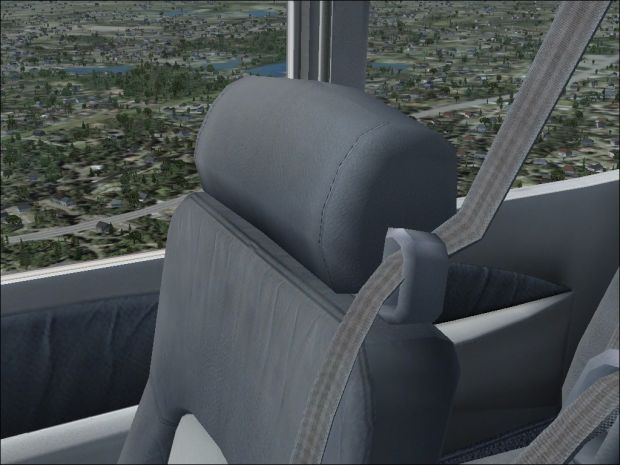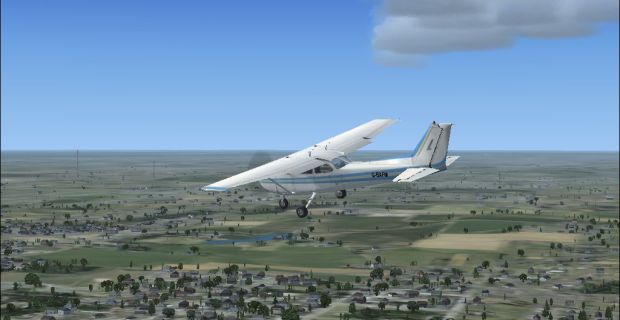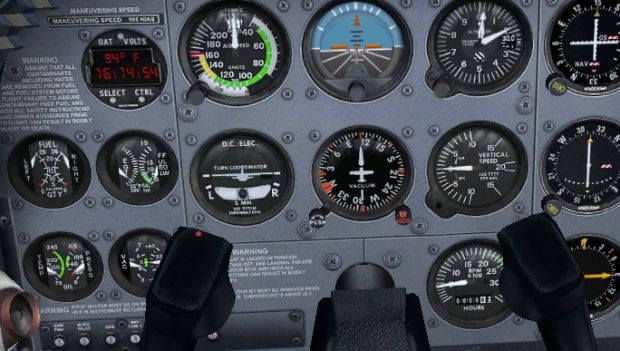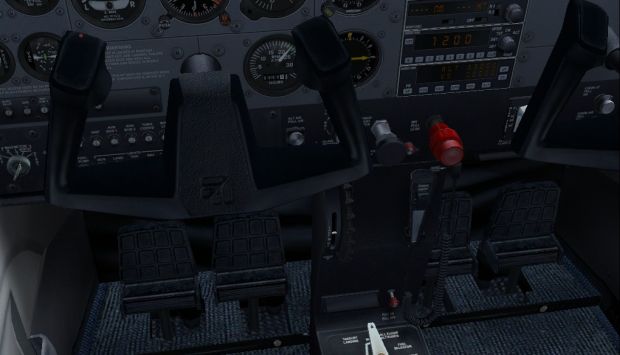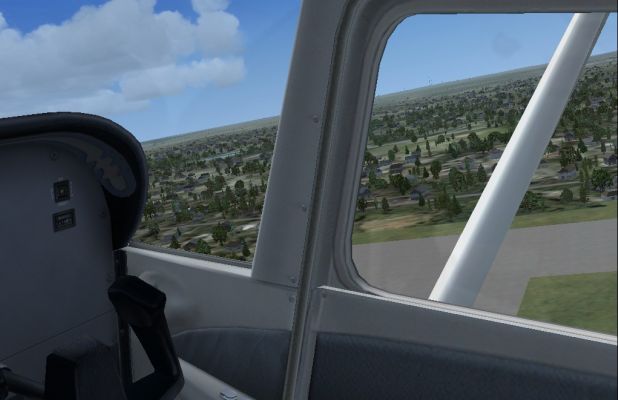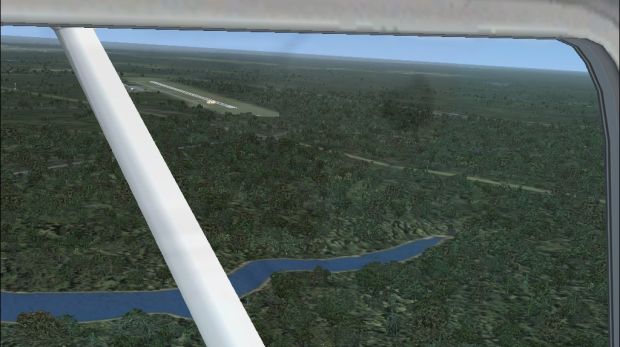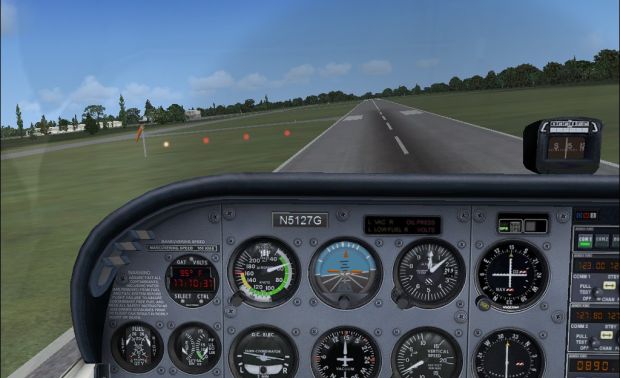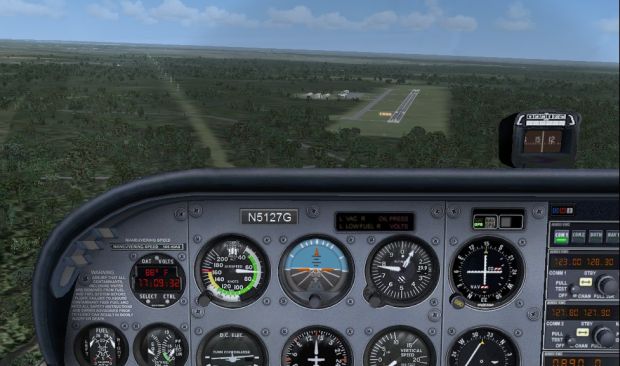Ridealong: Going Under The Wing Of A Flight Instructor
Learn to fly
Ridealong is our monthly feature where Brendan travels deep into game worlds to meet, question and journey with the inhabitants that dwell within. This time, he meets a flight instructor for a ‘virtual airline’ and sweats as he learns his way around the cockpit in Microsoft Flight Simulator X.
We are at 2000 feet when we begin to stall. I am absolutely certain I am going to crash this plane. We are tumbling to earth and all I can hear is the harsh buzz of the stall warning, telling me everything about this is wrong. But then I hear it, the voice of Dan “TX Hills”. He has a calm voice. As far as he’s concerned, everything has gone exactly the way it was supposed to.
Dan is a flight instructor for a virtual airline. I can’t actually see him in the cockpit with me (Microsoft Flight Simulator X has a robust multiplayer mode but even when sharing planes there are no models for separate players). He is also a real life pilot – he got his pilot’s licence in 1969, just 4 days after his 17th birthday – and flew for years in the Civil Air Patrol. Not only has he been flying for years, he has thousands of hours in flight sims too.
I can boast no such thing. I have never played a flight sim, except once as an 8-year-old. At one point, as we talk on the runway, I can hear a huge clap of thunder coming from Dan's home near San Antonio, Texas. His cat, he tells me, has gone darting under the nearest bed. I don’t know it yet but there will be plenty of moments today when I feel like that cat. Dan is going to teach me how to fly.
His virtual airline has been around for about a year and a half, an outfit called Elite PremAir Virtual. It has a couple of hundred members but Dan reckons only about 60 of those are active – a “typical number” for organisations like his. A virtual airline is something you can join to fly, chat and simulate flights with other people. From pilots and co-pilots to those working in “the tower”.
“For us, we pretty much will take anybody,” says Dan. He has the soothing voice of every pilot I have ever heard. “They start out in a smaller aircraft flying shorter routes and work their way up in rank. Other airlines have similar kinds of things. If you want to do air traffic control, you can. But similarly you do need to have some orientation and training. We don’t just let anybody jump in there and do that.
“As you gain time, you get promoted and this is probably the fundamental thing for any virtual airline. It’s the ‘time of flying’ that gets you promoted. If you’re going to be a flight instructor, you generally have to have some way of proving you can do that.”
We’re sitting on the tarmac at Richmond International, Virginia, inside a Cessna C172, a popular training aeroplane. We’re connected to pilots all over the world via the DAF Sim system – a network of servers that let’s pilots see each other. When I look out my window, I can see a jet idling beside a hangar. Another pilot waiting to take off.
It isn’t the only network of pilots out there, criss-crossing each other on a shared map. VAT Sim is another big group, complete with air traffic controllers who must undergo their own training and then have to give directions and warnings to those flying as pilots. It’s a complex job and could probably fill a whole other Ridealong. (If you want to know more about VAT Sim, Pip has you covered).
“That kinda gets the full realism of a VA flight,” says Dan, about VAT Sim. “You’re flying a particular aircraft on a real world route and you file that route as a flight plan, and then you come under the control of air traffic control just like you would in the real world.”
In some virtual airlines, pilots are even rewarded with in-game currency – their airline paying out when you complete long-haul passenger flights and so on. Some airlines even penalise their pilots for rough landings or reward them for ‘fuel optimisation’. Some even charge their pilots rent for housing their planes. Thankfully, Elite PremAir is not as strict as all that. After all, they are letting me fly.
I ask, as if out of curiousity, if there are many crashes in Dan's airline?
“For the truly active people, that’s an extremely rare [thing]…. I can’t even say if it’s ever happened. You rarely see anything significant like that.”
I make a mental note of this. Do not crash.
Dan takes control of the aircraft and backs it up a little, turning to face a yellow line.
“I’m going to have you taxi,” he says, meaning I’ll have to drive up to the runway. “I’m showing no winds, so winds aren’t a factor here.”
I start driving out to the runway, following the yellow line on the ground. But I am going much too fast. I should be going at about a quarter of this speed, Dan says.
“Do you have brakes somewhere?”
I pull the trigger on my joystick and the plane halts.
“There you go.”
We stop at another yellow line – the hold short line – and he explains about the runway number, how it corresponds to magnetic heading, and runs through all the instruments in the panel in front of me. The air speed indicator, the gyro-horizon, the altimeter, the turn-and-bank indicator, the whiskey compass. My brain tries to cram all these in, attempting to comprehend what each of them means. I nod along to my instructor’s explanations, unseen, pretending that I grasp more than 50% of what I have just been told, that I am not simply focusing on the four warning messages permanently etched on the panel.
Dan points out a number plate at the top of all the instruments.
“N5127G”
It’s the tail number – like a license plate - of the plane Dan actually learned to fly in, back in the 1960s - a Cherokee 140. Years later, the number is still with him, accompanying other learners into the sky. At least that’s one thing I can fully understand, a single reassuring thing about the cockpit, apart from Dan’s voice and his actual presence, of course.
He continues the tour of instruments and dials, explaining the colours on the air speed dial. Green is good, white means stall.
“Stall is an aerodynamic phenomenon where basically the wing fails to have lift.” he says. “And failure to recover from that leads to a...”
He hesitates for the smallest second.
“… a really poor outcome.”
I frown.
“Unless you’re really rich and then the outcome’s good!”
I smile.
“But not for you. For your relatives.”
I frown.
“So that’s a key one,” he says. “That’s one you want to keep your eye on.”
The dials are hard to grasp but as the lesson goes on I’ll start to figure them out. There’s a lot to take in and real-life pilots are expected to know these instruments back to front, inspecting them at all times during a flight, glancing from one to the other in quick and comprehensive succession.
“The life expectancy of non-instrument rated pilot in true instrument conditions is less than 25 seconds,” Dan tells me as he’s going through more dials. “To the right of that one -
“Wait,” I ask. “What does that mean? ‘True instrument conditions’?”
“IMC, or Instrument Meteorological Conditions,” Dan recites with textbook authority, “means conditions where you have lost the ability to orient your position by references on the ground or other fixed references.”
“In other words,” I say, “without your instruments you are much more likely to die.”
“Right, but also if you are not ‘instruments-rated’, even though you have these instruments, you’re still gonna die.”
“Good to know.”
Dan sidles the plane away from the hold short line, and gets onto the runway. He is going to do a circuit once to give me a taster. He takes off, lifting us into the air smoothly. I feel good about this. I have no fear of flying - I quite like it - and I have certainly no fear of it when it’s simulated. It’s only when the controls are in my hands will I start to become anxious.
We cruise around as he explains some more things to me – trim, flaps, how pitch raises and lowers your air speed. We do a “lap” over the land around the airport. I decide to make myself more nervous by asking stupid questions. Has anything disastrous ever happened during a real world flight? Not quite, he says, but almost.
He was doing some ‘touch and gos’ around an airport as a young pilot one day. This is when you do a circuit in the air, land on the runway and immediately take off again within a few seconds. But the airport was what they call a ‘sucker hole’ - an airport that seems clear and clean but as soon as you get a certain distance from the runway it becomes difficult to see anything at all. The visibility drops off a lot, fast.
Dan was descending, about 600ft from the ground and getting ready to land, when out of the clouds came a Cessna Super Skymaster – a twin engine plane with propellers on the front and back. It was coming right at him.
“And this idiot comes out of the clouds and the standard thing to do in this situation is to turn right, to avoid him. And so if one [person] is coming towards the other, you turn in opposite directions. But what does he do? He turned left.”
Dan held his right turn and waited. Thankfully, the Skymaster pilot corrected in time, finally turning right and averting disaster. Even so, Dan says, that pilot had also been only one hundred feet or so from some power lines, hidden in the mist. Nothing happened to him, whoever it was, but it was a dangerous flight.
We’ve done our lap now and he takes us in to land, describing all the time what he’s doing. By talking during the landing he is violating the ‘sterile cockpit’ rule, he says. You normally aren’t supposed to chatter or pass things around or anything like that. Despite this, we touch down, just as smoothly as we’d taken off.
“Do you think you’ve got the gist of it here?” he asks.
I am 90% sure that I do not. But I hear my voice lying.
“I think so,” it says.
He hands control of the plane to me and I line it up on the runway.
“You can do this,” he says.
I push the throttle forward all the way, slowly. We start racing down the runway. At 40 knots, he tells me to start pitching up. The plane starts to rise above the earth. It is nerve-wracking. The fear probably has nothing to do with piloting a fake plane and everything to do with the fact there is a certified expert sitting next to me. We get up and away, and start to level out. That wasn’t so tough after all, I think.
Dan takes control mid-air to adjust the trim for me. Meanwhile I have pressed buttons I should not have pressed and now my view is focused exclusively on the seat underneath my own ass. It takes me a minute to adjust. I am an excellent pilot.
Eventually, I get control of the plane back. I finally take the time to really look at the sky. I am glad the weather is good. Dan must be too. One day, he tells me, he was flying from Maryland to Massachusetts in beautiful weather, for real this time, with his father and an old friend on board. They dropped the friend off, refueled and turned around. Just as they passed over the Hudson river a severe thunderstorm appeared right in front of them.
“Are we gonna turn around?” his dad asked.
“In a minute,” said Dan, nonchalantly inspecting the clouds.
And in exactly one minute, he turned the plane around.
“Yeah,” he said “I’m getting out of here.”
They called an air traffic controller who said that 26 other planes were facing the exact same problem – an unforecast storm playing havoc with their flight plans. Go and deal with the others, said Dan, knowing he and his father had plenty of fuel left in their own plane. They flew in circles above the Hudson for 20 minutes, until the air traffic controller came back to them and gave them a path out.
“That was the prudent thing to do,” he tells me. “Thunderstorms are very dangerous. Even for instrument-rated pilots. The forces, the winds that can occur – they can be very dangerous.”
I’m glad that the sky is clear in the simulator. But I’m not entirely out of the woods. After doing a couple of turns in the air, bringing us back towards the airport, Dan decides to spice things up.
“Not very long after I started to learn to fly,” he says, “they made stall training mandatory.”
Uh huh.
“This is the thing that kills most pilots – stalling the aircraft.”
Right.
“So I’m going to have you do that. To see what that’s like.”
I react as expected.
“WE’RE GOING TO STALL THIS?” I ask.
“We’re going to stall this.”
I laugh, nervously.
“It’s going to be an aerodynamic stall, and I’m going to teach you how to recover from it, and it’s not going to be a problem.”
“OK,” I say. My tone could be described as: whimpering.
He tells me to pull the throttle all the way back, effectively cutting our power. The noise of the engine dies away to almost nothing. I have to keep the plane level for now. After a few seconds, Dan says to pull back on the stick.
“Be prepared to add throttle.”
Our nose goes up slightly.
“Keep pulling back, keep pulling back, keep pulling back… It’s not going to stall until -
The plane dips fast.
“There you go!”
The stall warning goes off – an angry continuous beep. We start to fall toward the ground.
“Now push forward and add power.”
This goes against all my intuition. Pushing forward makes us go down, I’m thinking. But we’re already going down. Dan’s voice is so calm, however, so placid about the whole thing, that it is impossible not to do as he says. And sure enough, as the engine comes back to life, he tells me to start pulling up again. Within seconds we are flying level once more, as if nothing had happened. The whole thing took about 60 seconds. I am sweating heavily.
“That was not too bad,” I say, exhaling loudly.
With that over, we start our descent proper. Dan puts the plane into auto-pilot and does one of the last turns for me. I take my hand off the joystick for the first time in what seems like an era. My palm is sweaty and my fingers are stiff. It’s pretty exhausting to learn this stuff. According to Dan, one hour of flying a plane is the equivalent to three hours driving a car, in terms of how much energy it takes out of you.
In reality, he doesn’t fly any more. He had been part of the Civil Air Patrol, an auxiliary of the air force established in the 1930s for volunteers, which now offers cadet programs, education and support for search and rescue missions or disaster relief. Then he was a ‘general aviator’. But he hasn’t flown a plane for years now. On top of the expense of it, the time he would need to put into flying to stay proficient is too much to ask nowadays. You have to practice consistently to stay good.
“We don’t do that any more, although I may one day get back into it.”
Even if he wasn’t grounded, however, the sim is still something he would do. It’s the same for a lot of pilots he says. One of his colleagues at Elite PremAir is an Airbus 320 pilot in real life working for Air New Zealand.
He turns autopilot off, prompting another harsh buzz from the instrument panel. When I am abeam of the runway, he says, I need to turn. I have to ask him what “abeam” means.
After one final turn we are heading more or less toward the runway. I say “more or less” because it feels like I am coming in far from straight. All the way down Dan is giving me directions, adjusting the flaps, and talking me through it. The tension is almost painful, I barely want to breathe.
“Now cut the power… line yourself up to the runway… little bit to the left… okay, a little more power now… you’re looking very good… just a whiff high but you’ve got plenty of runway to work with… ease back on the stick, easy on the stick, easy on the stick.”
The wheels touch down. Dan congratulates me on my first landing. I breathe out a huge sigh.
“Whhoof!”
“All right give me full power,” he says.
What?
“Give me full power.”
I throttle up.
“All right we’re going to take off. Just pull back gently on the stick, I got your flaps up, aaaand….”
We rise back into the air, mere seconds after having touched down.
“...you’ve had your first landing and now you’ve just done your first 'touch and go'.”
I’m sweating again. But Dan is taking me for one last circuit, just to be sure. These patterns are repeated by pilots again and again – up and down, touch and go. It only takes us seven minutes this time to get back on the tarmac. On this landing, I tell Dan that I’m bugging out. My hand is cramped, I’m mentally exhausted, and I stink of fear. I simply can’t face going into the sky again.
“You did extremely well,” he says. “You really did.”
I thank Dan for everything and go make myself a cup of tea. I feel like I’m coming down, and not just from the clouds. How wonky that second landing was. How uneasy every turn I made. It’s odd, I can pilot a spaceship through tiny docking bays, or run through the trenches of Normandy, but just one and a half hours of this has me burnt out. I don’t think I’m cut out for flying, even in a simulator.
Later, I get an email from Dan. He has sent me a picture of the run we did – the ‘breadcrumb’ trail of the route we took.
“That ‘perfect rectangle’ is what you are going for,” he says “and you pretty much hit the bulls eye.”
If you want to learn to fly, visit Elite PremAir Virtual, or check out the multiplayer discussion threads on Steam. For more Ridealongs, click here.
Update: One of the stories Dan told me was originally described as a "simulated" flight. But it was a real flight. He really did avoid a mid-air collision. This has been fixed.


